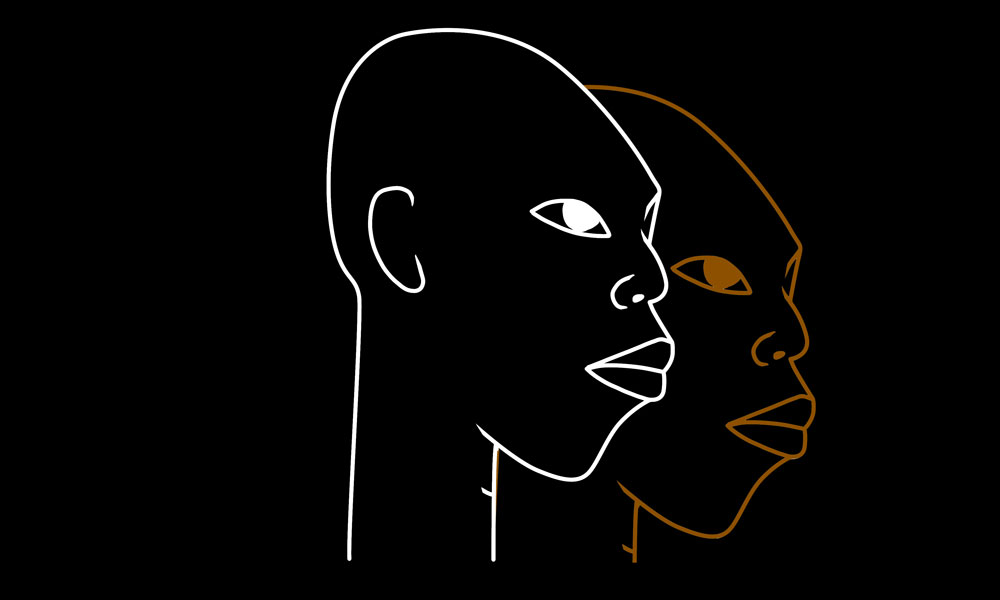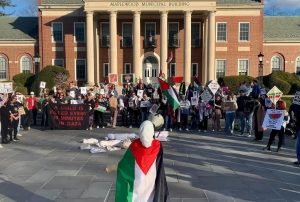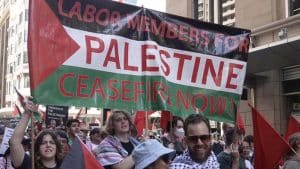This independent Negro movement is able to intervene with terrific force upon the general social and political life of the nation, despite the fact that it is waged under the banner of democratic rights … We say that it is is able to exercise a powerful influence upon the revolutionary proletariat, that it has got a great contribution to make to the development of the proletariat in the United States, and that it is in itself a constituent part of the struggle for socialism. — C. L. R. James, “The Revolutionary Answer to the Negro Problem in the United States,” speech at Socialist Workers Party conference, 1948.
The history of class struggle in America is inherently connected to the struggle for Black liberation. The rebellions in Baltimore, Maryland and Ferguson, Missouri after the murders of Freddie Gray and Michael Brown by police officers revealed that, although the United States elected its first Black president in 2008, the majority of Black people continue to suffer the exploitation and oppression inflicted by the imperialist state. The spirit of Black liberation set the country ablaze with the emergence of the Black Lives Matter movement.
Get your copy of Left Voice magazine, which includes this article.
The idea that African Americans would gradually achieve their full freedom under the current system proved to be nothing more than an illusion. The American state has amply demonstrated that racial oppression is inscribed in its DNA. The abolition of slavery and the abrogation of segregationist laws were not gained by the grace of the white ruling class in America, but by the struggle of many generations of Black people.
An anti-capitalist perspective is necessary for the success of the struggle for Black liberation. There are wings of the Black liberation movement that consider Black affluence to be a challenge to white supremacy. Some sectors consider this a form of “representation,” since it allows a few Black people to be admitted into the capitalist class.
However, capitalism serves only a small class of individuals, and although it now includes some Black capitalists, the vast majority of Black people are languishing under this economic system. Historically there has been support for “Black capitalism” because the state has fought tooth and nail throughout history to prevent its progress. But as the Obama presidency showed, neither Black capitalism nor Black representatives in the capitalist state will lead to Black liberation.
The only way to end systemic racism is to end capitalism, and the only way to lead a powerful movement against capitalism is to root out the racism that still prevails in large sections of the working class. This was understood by broad sectors of the Black communities influenced by socialist and communist ideas from the 1920s onward.
Unfortunately, after the 1960s and 1970s and with the acceleration of the neoliberal offensive, the struggles for Black liberation and socialist revolution began to grow apart. It is imperative to reestablish the unity between Black and anticapitalist struggles and reconstruct the history of the relationship. While some left organizations downplay racism as if it is not a primary issue, we believe that Black liberation is at the heart of class struggle in America, and that the fight against racism should be at the center of a left organization’s practice.
In this article, we focus on the period of the 1920s and early 1930s, when Black struggle gained great importance in the national arena and socialist ideas flourished within it. The experience of the Communist Party during this period offers valuable insights for socialists today.
The First Great Migration and the Nationalization of the Black Question
At the end of the nineteenth century and the beginning of the twentieth century, U.S. capitalism was undergoing its transformation into an imperialist power.
Although the global hegemony of the United States did not materialize until the end of the Second World War, the U.S. economy was already entrenched in the bustling race for mass production and rapid urbanization by the early 1900s. The Black community, mostly concentrated in the southern United States until the 1920s, also suffered the consequences of this industrialization process:
When the century started, blacks were still a peasantry with about 83% of the population working on farms. This radically changed over the next 50 years. By midcentury, African Americans were now an urban people, with over 60% of the population living in cities. The community was dominated by an industrial proletariat and a small cadre of white-collar and professional service workers. The city was the black people’s land.1H. L. Taylor Jr., The Long Struggle for Black Liberation (Buffalo, NY: Center of Urban Studies, University at Buffalo, 2015).
The Great Migration involved the exodus of six million Black people from the South to the North of the United States from 1916 to 1970.
From 1916 to 1940, at least 1.5 million Black people migrated from the South to the nascent northern cities. Migration made the emergence of a new Black proletariat possible on the one hand and an emerging urban petty bourgeoisie of artists and professionals on the other. With migration, the Black struggle began to take on a national character. Black America was proliferating, and writers like W. E. B. DuBois pointed out that the “Black question” was at the heart of U.S.’s great problems:
The problem of the twentieth century is the problem of the color-line—the relation of the darker to the lighter races of men in Asia and Africa, in America and the islands of the sea. . . What shall be done with Negroes? Peremptory military commands this way and that, could not answer the query; the Emancipation Proclamation seemed but to broaden and intensify the difficulties; and the War Amendments made the Negro problems of to-day.2W.E B. Du Bois, The Souls of Black Folk (Chicago: A. C. McClurg, 1903).
These were the years of the Great Depression, the struggle against the Ku Klux Klan in the South, and an unprecedented process of organization and politicization in the Black liberation movement. For the next twenty years, with the emergence of the new Black intelligentsia and urbanization came dozens of Black organizations fighting segregation laws, such as the Niagara Movement (1903), the National Association for the Advancement of Colored People (1909), and the Urban League (1910).
In this context and against the backdrop of the Great War, an international event changed the configuration of the Black movement—the Russian Revolution of 1917.
The Russian Revolution and Black Liberation
The Russian Revolution inspired the exploited and oppressed all over the world, and Black people in America were no exception. In November 1917, John Reed sent a cable to the socialist publication New York Call from Petrograd: “This is the revolution, the class struggle, with the proletariat, the workmen, the soldiers and peasants lined up against the bourgeoisie.”3Quoted by John Reed, “In Defense of October,” International Socialism 52 (London) (Autumn 1991).
The 1917 Russian Revolution showed the working class and the most oppressed the inspiring glimmer of a future beyond the limits of capitalist oppression. Internationally, the Russian Revolution had a major impact on class struggle and demonstrated that, even in backward capitalist countries like Russia and the countries of the African continent, the masses could lead a revolution. One of the aspects of the early imperialist era
Was the division and rule of the African continent by 15 European countries at the Berlin Conference of 1885. The expansion of the Russian Revolution, the defeat of the European bourgeoisies, and the victory of the working class in these imperialist countries—which included France, Germany and England—would have been a fatal blow to their colonial project in the African continent. At the same time, the weakening of the European bourgeoisie would have increased the chances of African workers and the oppressed of overthrowing imperialist rule in their regions.4Marcello Pablito, “Revolution and Black Struggle,” Left Voice, no. 3 (2016).
The Early Communist Party and the Black Question
In 1919, the inspiration of the recent revolution in Russia led to the emergence of the Communist Party of the United States (CPUSA) in the midst of the break-up of the left wing of the Socialist Party5In reality, two communist parties initially emerged from within the socialist movement, but on the advice and policy of the Bolsheviks, they quickly unified. and other radical organizations. The rank and file of the Socialist Party (SPUSA), inspired by the Russian example, quickly turned to the left. The same year, American communists suffered virulent government repression6The repression visited on the communists led to a short but important period of disorganization and disorientation. The communists at the time raised the need to act clandestinely. However, also on the advice of the Bolsheviks and because the political and social conditions did not warrant taking the party underground, the U.S. Communists emerged from their clandestine state. in the form of the “Palmer raids,” resulting in the apprehension of more than six thousand US-born and immigrant communists; over five hundred were deported.
From 1920 to 1950 the CPUSA was one of the most influential organizations of the working class and Black population in the country. The orientation of the party toward the Black liberation movement arose from (1) an intense internationalist collaboration and debate between the American communist militants and the Communist International (CI) and (2) the influence that the party received from Black radicalism in America, which, inspired by the Russian revolution, began to turn left.
The communist militants came from the ranks and tradition of the Socialist Party; Black liberation was not at the center of their political practice. The American socialists had of course been trained in anti-racism, but even for Eugene Debs, one of its founders and most prominent figures, racial oppression did not deserve special attention:
There is no Negro question outside of the labor question. The real issue … is not social equality but economic freedom. The class struggle is colorless. The capitalists, white, black, and other shades, are on one side and the workers, white, black and all other colors, on the other side.7Quoted by Jacob Zumoff, The Communist International and U.S. Communism, 1919–1929 (Leiden: Brill, 2014), 289.
It was therefore not surprising that the nascent Communist Party would still be blind to the importance of the Black question in the United States. The Bolsheviks, while not experts on the Black question, recognized in the early stages of their organization that the issue of racial oppression was deeply linked to revolutionary politics in the U.S. The nascent Soviet Union granted the right of self-determination to nationalities and minorities—such as Muslims—who were oppressed under czarism. These national minorities flourished socially and culturally after the revolution.8Robert Belano, “What Can We Learn from the Bolsheviks’ Policy toward Muslims?,” Left Voice, no. 3 (2016).
As Jacob Zumoff points out in his book, The Communist International and U.S. Communism,
As early as 1913, Lenin had noted the importance of the Negro question when he wrote: “Everyone knows that the position of the Negroes in America in general is one unworthy of a civilised country—capitalism cannot give either complete emancipation or even complete equality.”9Zumoff, Communist International, 291.
Beyond the fact that some communists had experienced or witnessed the oppression of Black people in America first-hand,10As David Reynolds documented in his book Mightier Than the Sword: Uncle Tom’s Battle for America (New York: W. W. Norton, 2011), communists Alexandria Kollontai and Sen Katayama were exposed to the living conditions of African Americans and played a role in convincing the Comintern to address them. the Bolshevik Party was especially sensitive to national, ethnic, and gender oppression. Zumoff writes,
Generalising from the Russian experience, the Bolsheviks emphasised anti-imperialism and anti-colonialism. Since special oppression often was integral to capitalism, struggling against it could spark broader social struggles. This understanding compelled the Bolsheviks to sense the importance of the “Negro question.”11Zumoff, Communist International, 293.
Thus, Lenin insisted that John Reed present a special report on the Black question in America for the Second Congress of the Communist International in 1920. The resolutions passed at the Second Congress were then ratified in the Fourth Congress of the CI (1922) and ultimately guided the party’s orientation toward the Black question until 1934. That is, despite the growth of Stalinism within the Communist International through the “Third Period,” the Soviet bureaucracy was only able to discipline Black American communists after 1934.
John Reed’s report to the Second Congress stated that
The Communists must not stand aloof from the Negro [sic] movement which demands their social and political equality and at the moment, at a time of the rapid growth of racial consciousness, is spreading rapidly among Negroes. The Communists must use this movement to expose the lie of bourgeois equality and emphasize the necessity of the social revolution which will not only liberate all workers from servitude but is also the only way to free the enslaved Negro people.12John Reed, “America and the Negro Question: Report to the Second Congress of the Communist International,” Publishing House of the Communist International (1921).
Reed insisted that any revolutionary policy for the period must include the fight against racism and support for the struggles of Black people on an international scale. After stating that “the enemy of [the Black] race and of the white worker is identical: Capitalism and imperialism,” the resolutions affirmed that
The Communist International should struggle for the equality of the white and black races, and for equal wages and equal political and social rights. The Communist International will use every means at its disposal to force the trade unions to admit black workers, or, where this right already exists on paper, to conduct special propaganda for their entry into unions. If this should prove impossible, the Communist International will organize black people into their own unions and then use the united front tactic to compel the general unions to admit them.13John Riddell, Toward the United Front: Proceedings of the Fourth Congress of the Communist International, 1922 (Chicago: Haymarket, 2017), 948.
The attention that the Communist International gave to the Black question at its first four congresses converged with the development of Black radicalism in America. The Russian Revolution resonated among the Black liberation movement, building a socialist left wing. This radicalization stemmed from growing discontentment with the policies of influential organizations such as the NAACP. As a by-product of this discontent, organizations like the African Blood Brotherhood formed, with young Black leaders like Cyril Valentine Briggs at the head, who saw the struggle for Black liberation as an anti-colonial and anti-imperialist struggle. Once the Communist Party was founded, these two organizations merged in 1921. This fusion was an expression of the strong relationship between communism and Black liberation.
The Third Period
In 1923 the German revolution was defeated. This defeat paved the way for the demoralization of the European proletariat and a period of capitalist stabilization. Although the German revolution failed, the majority of the Communist International concluded that a global stage of the radicalization of the masses was developing.
This incorrect characterization and the refusal of the CI majority’s to draw objective conclusions about the significant errors in Germany led the International to adopt a policy known as the “Third Period.” This orientation was based on the idea that socialist revolution was inevitable. This characterization had its correlate in an ultra-left and sectarian position of the CPUSA from 1929 to 1934.
During the years of the Third Period, the CP created the Trade Union Unity League (TUUL) to build “red unions” or “revolutionary unions” in opposition to the existing unions in the American Federation of Labor (AFL). The red unions required workers to agree to the CPUSA’s program in order to obtain membership. Charles Post describes this tactic:
The CP’s trade union sectarianism had particularly tragic effects in the steel industry. There the sizeable CP fraction refused to participate towards the growing rank-and-file movement in the Amalgamated Iron and Steel Workers (AFL) agitating for a general strike to win union recognition during 1933 and the first half of 1934. Instead, the CP maintained its relatively small “red union”—the Steel and Metal Workers Industrial Union—rather than entering and giving organizational and political direction to the insurgent Amalgamated “lodges” (locals).14Charles Post, “The Popular Front: Rethinking CPUSA History,” Against the Current, no. 63, July-August 1996.
Despite this ill-fated direction, it was precisely during the Third Period that the CPUSA made its most important inroads in the Black movement. This was a result of the Communist International’s preservation of revolutionary elements. In relation to the Black question, its policy upheld the resolutions approved at its 1928 congress. These established that the Black struggle could be characterized as the struggle for self-determination in the Black Belt of the South, and the fight for equal rights and integration in the North.
In the North, the communists organized democratically-functioning interracial councils of the unemployed; fought segregation in education, housing, and health; and built solidarity committees against lynching in the South.
In a sectarian way and as a result of the Third Period line, the CPUSA rejected any kind of common action with the Socialist Party in the South, but it managed to organize rural salaried workers and sharecroppers’ unions.
In industrialized cities like Birmingham, Alabama, unions organized by the communists were at the forefront of the militant labor movement. They also agitated against segregation and for voting rights for Black people, and in many cases they became part of the armed self-defense against the lynchings perpetrated by the Ku Klux Klan. In Alabama in 1930, the communists organized millions of people (Black and white) in defense of the “Scottsboro Boys,” young Black men who were falsely accused of raping two white women.
The communist militants in the South developed all sorts of initiatives to organize the Black working class. As Robin D.G. Kelley explains in Hammer and Hoe, the interweaving of classes in the racialized capitalism of the South posed unprecedented challenges for communists:
The relations between industrial labor and capital, and landlords and tenants, were clouded by divisions based on skin color. On the surface, at least, it seemed that there existed two separate racial communities in the segregated South that only intersected in the world of work or at the marketplace. Sharp class distinctions endured within both black and white communities, but racism tended to veil, and at times arrest, intraracial class conflict as well as interracial working-class unity. Alabama Party leaders could not escape the prevalence of race, despite their unambiguous emphasis on class-based politics. Indeed, during its first five years in Alabama, the CP inevitably evolved into a “race” organization, a working-class alternative to the NAACP. As Nell Painter observed, the rank-and-file folk “made the Party their own. In Alabama in the 1930s, the CP was a southern, working-class black organization.”15Robin D. G. Kelley, Hammer and Hoe: Alabama Communists during the Great Depression (Chapel Hill, NC: University of North Carolina Press, 1990).
The initiatives promoted by CPUSA members in Alabama combined patient work in the unions that recognized the importance of the fight against racism, and also spearheaded the organization of democratic bodies in Black communities that would take up pressing problems in cities like Birmingham.
Kelley also describes the adverse conditions under which Black and white communists organized Alabama’s Black working class and the degree of influence they achieved over large sections of the Black community.
However, the state’s fierce repression, combined with the political course followed by the leadership of the Communist Party, eventually liquidated the heroic experience of Alabama.
The Shift to the Right
The Communist International’s growing bureaucratization and shift to the right had a great impact in the United States. Starting in 1934 under the control of Stalin, the Comintern shifted again, this time to the right. Leaving behind the ultra-left period, the communist organizations embraced the “popular front.” In the United States, this implied subordinating the party to the government under the Roosevelt administration, which had a direct impact on the CPUSA’s relationship with the Black liberation movement. As C.L.R. James says,
The CP has lost 1,579 or 79% of its Negro membership during the last year in New York State alone. Since that time, there has taken place the split of the Workers Alliance, and New York is slated to be always symptomatic of developments in the Party as a whole… The chief reason for this is, of course, the new Popular Front turn of the CP. The CP cannot gain the allies it wants if it fights the difficult fight for Negro rights. The CP is now an American party, and the petty bourgeois supporters of democracy who are coming into it have nothing in common with the Negro, who, finding himself an outsider, has simply left the Party.16C.L.R. James, “The Revolutionary Answer to the Negro Problem in the United States,” speech at Socialist Workers Party conference, Fourth International, December 1948.
In Moscow, the Stalinist bureaucracy—in complicity with the US leadership—forced the CPUSA members to stop organizing within the Black liberation movement under the argument that, by appearing before the masses as a Black organization, the party was alienating white workers. The CPUSA’s abandonment of a decisive orientation toward the Black liberation movement correlated with its support for the New Deal and its subordination to the emerging labor bureaucracy.
The immediate consequence of the popular-front turn of the Communist Party was to ally with liberal Democrats in the South and reformist organizations in the labor movement. Even though the Communist Party continued to push for interracial organization of the unions, it did so by abandoning the principle of class independence and thus abandoning the revolutionary roots of the early years.
Right before the third period and the subsequent right turn, three communist leaders were accused of “Trotskyism” and expelled from the CPUSA: James P. Cannon, Martin Abern, and Max Shachtman. From the heart of the CPUSA emerged what would later become the American section of the Fourth International founded by Leon Trotsky. This nascent organization drew lessons from the experience of the Communist Party toward the Black liberation movement and from it emerged one of the most prominent Black revolutionary leaders and thinkers: C.L.R. James.
The importance of early Trotskyism in the U.S. is that, among other things, it preserved the Bolshevik tradition of a revolutionary policy for Black emancipation, which had been articulated in the CPUSA’s early years.
Moving Forward
The importance of reconstructing the relationship between Black struggle and socialist revolution is not merely a historical exercise. The influence of the Bolshevik Party in the 1920s and 1930s helped forge a revolutionary faction within the Black liberation movement. This faction developed thanks to the lessons of the Russian Revolution. An entire generation of communists was inspired by the early years of the Russian workers’ state. The centrality of the self-determination of oppressed nationalities and the struggle against racial and gender oppression was key to winning them over.
These experiences demonstrate that Marxism is not a “white ideology,” but rather, has served as a guide for the revolutionary emancipation of the oppressed majority.
Probably the most important workers’ upsurge in U.S. history took place in the 1930s, and the Black struggle was an essential component. Tens of thousands of Black workers joined far-left organizations, and the Communist International was devoted to the formation of a Marxist interpretation of the Black question in America.
This strength, dynamism and activity stands in stark contrast to the misrepresentations and class reductionism recreated by both the new U.S. social democrats who deny that racial oppression requires special attention, and the liberals who try to trick us into believing that the struggle for Black liberation is separate from the struggle against capitalism.
The marriage of capitalism and racism in the United Estates can be destroyed only by an enormous social force that smashes the foundations of the American imperialist state and the white supremacist ideology that sustains it. To that end, we must use the legacy of socialists in the Black struggle to rebuild the relationship between Black liberation and Marxism as a new political and social force.
Notes
| ↑1 | H. L. Taylor Jr., The Long Struggle for Black Liberation (Buffalo, NY: Center of Urban Studies, University at Buffalo, 2015). |
|---|---|
| ↑2 | W.E B. Du Bois, The Souls of Black Folk (Chicago: A. C. McClurg, 1903). |
| ↑3 | Quoted by John Reed, “In Defense of October,” International Socialism 52 (London) (Autumn 1991). |
| ↑4 | Marcello Pablito, “Revolution and Black Struggle,” Left Voice, no. 3 (2016). |
| ↑5 | In reality, two communist parties initially emerged from within the socialist movement, but on the advice and policy of the Bolsheviks, they quickly unified. |
| ↑6 | The repression visited on the communists led to a short but important period of disorganization and disorientation. The communists at the time raised the need to act clandestinely. However, also on the advice of the Bolsheviks and because the political and social conditions did not warrant taking the party underground, the U.S. Communists emerged from their clandestine state. |
| ↑7 | Quoted by Jacob Zumoff, The Communist International and U.S. Communism, 1919–1929 (Leiden: Brill, 2014), 289. |
| ↑8 | Robert Belano, “What Can We Learn from the Bolsheviks’ Policy toward Muslims?,” Left Voice, no. 3 (2016). |
| ↑9 | Zumoff, Communist International, 291. |
| ↑10 | As David Reynolds documented in his book Mightier Than the Sword: Uncle Tom’s Battle for America (New York: W. W. Norton, 2011), communists Alexandria Kollontai and Sen Katayama were exposed to the living conditions of African Americans and played a role in convincing the Comintern to address them. |
| ↑11 | Zumoff, Communist International, 293. |
| ↑12 | John Reed, “America and the Negro Question: Report to the Second Congress of the Communist International,” Publishing House of the Communist International (1921). |
| ↑13 | John Riddell, Toward the United Front: Proceedings of the Fourth Congress of the Communist International, 1922 (Chicago: Haymarket, 2017), 948. |
| ↑14 | Charles Post, “The Popular Front: Rethinking CPUSA History,” Against the Current, no. 63, July-August 1996. |
| ↑15 | Robin D. G. Kelley, Hammer and Hoe: Alabama Communists during the Great Depression (Chapel Hill, NC: University of North Carolina Press, 1990). |
| ↑16 | C.L.R. James, “The Revolutionary Answer to the Negro Problem in the United States,” speech at Socialist Workers Party conference, Fourth International, December 1948. |












